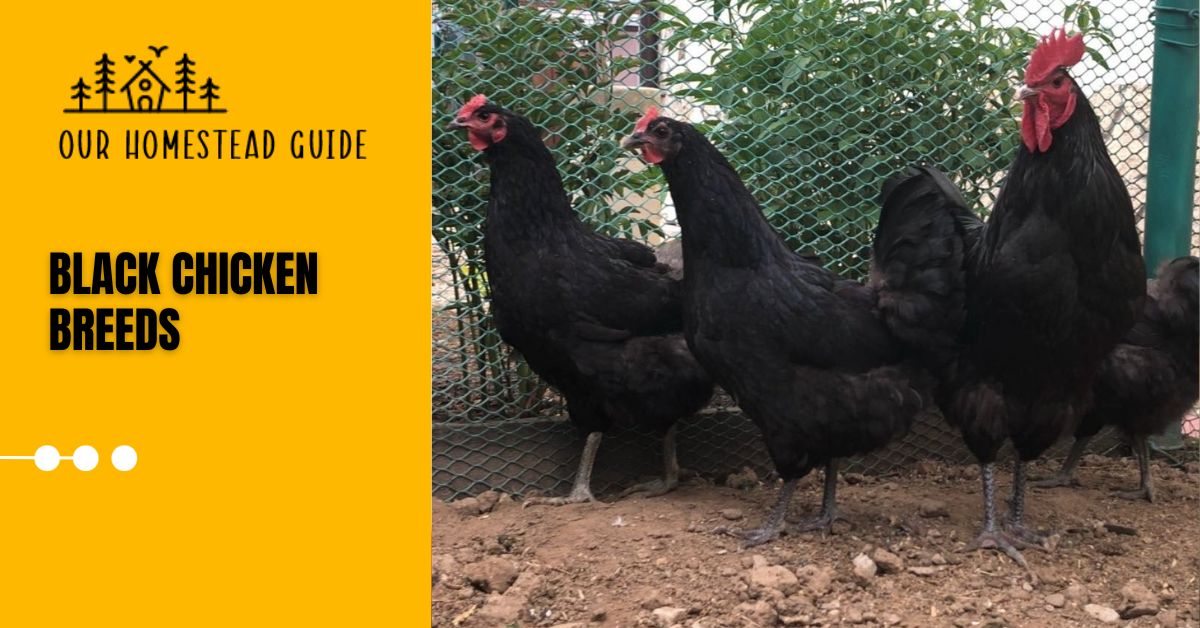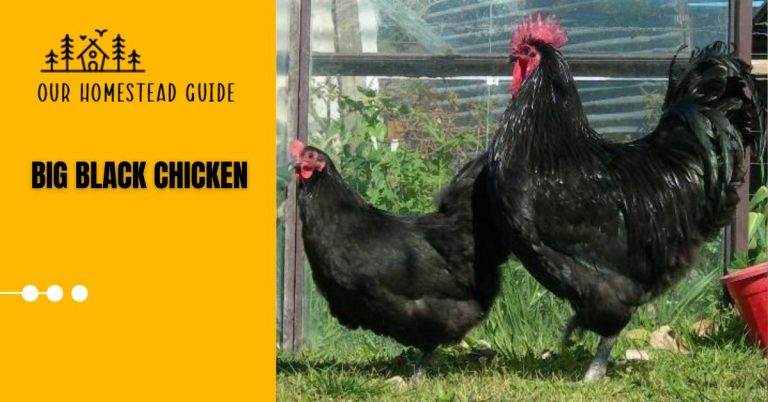24 Beautiful Black Chicken Breeds in the World
Big Black Chicken breeds might be a good choice for you. Black chicken breeds provide flocks an amazing diversity, ranging from elegant Black Australorps to endearing Silkies and the unusual Ayam Cemani. These gorgeous, dark-feathered creatures bring pleasure to breakfasts and backyards with their varied sizes and personalities.
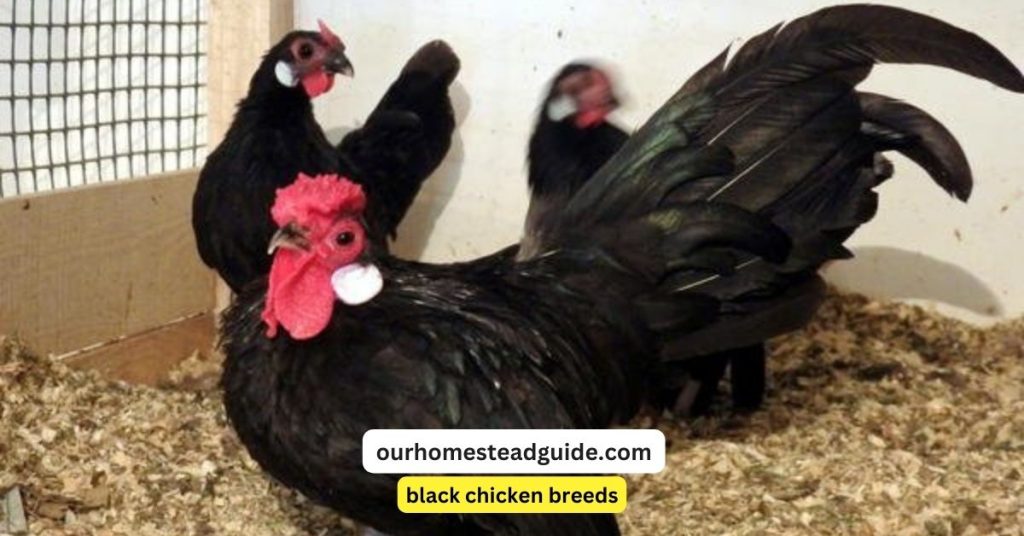
They are a compelling fusion of beauty and practicality and are well-known for their durability and sociability. Examine these different striking varieties to improve the visual attractiveness of your chicken herd.
Beautiful black chicken breeds
Here’s a tabular summary of some of the most well-liked black chicken breeds:
Different Awesome Types of Black Chicken Breeds
Here are Different popular black chicken breeds:
| Breed Name | Origin | Appearance | Egg Color | Special Characteristics |
|---|---|---|---|---|
| Ayam Cemani | Indonesia | Completely black, including feathers, skin, and organs | Cream to light brown | Considered a rare breed; highly prized for its mystical appearance |
| Australorp | Australia | Black plumage, greenish-black sheen | Brown | Excellent egg layers, holds world records for egg production |
| Black Jersey Giant | United States | Large, majestic birds with black feathers | Brown | One of the largest chicken breeds |
| Marans | France | Dark brown or almost chocolate-colored feathers | Dark brown | Known for their dark, rich eggs |
| Sumatra | Indonesia | Slender, game-like appearance with glossy black plumage | White | Known for their elegance and beauty |
| Swedish Black Hen | Sweden | Solid black with a red comb and wattles | Brown | Dual-purpose breed, good for both meat and eggs |
| Black Australorp | Australia | Similar to the Australorp but with a focus on the black color | Brown | Excellent egg layers, friendly temperament |
Ayam Cemani

- Purpose: Dual-purpose (meat and eggs)
- Average Weight: 4-6 lbs
- Egg Production: 80 per year
It follows that it is inherently thought to be a lucky charm. In Indonesia, Sumatra, Java, and Madura Island are where it is typically raised. This bird is used in many civilizations’ pre-event ceremonies.
This chicken has black skin, feathers, and internal organs, among other things. Even Ayam Cemani’s blood has a deeper crimson color than usual. Fibromelanosis is a hereditary disorder that affects every part of the bird, which is the reason for its dark hue. This bird, which was just brought to Europe in 1998, is becoming more and more well-known in the US because of its unusual look.
Do your homework before you buy since, regrettably, many breeders are purposefully trying to pass off hybrid chickens as purebred Ayam Cemani as the bird becomes more and more popular. For this reason, it might be costly to buy this kind of chicken. Up to $5,000 can be spent on a mating couple.
The Ayam Cemani is a middling breed that can be raised for either meat or eggs. The eggs are typical in size and have a cream hue. This bird lays around twenty-five eggs at a time, pauses for a while, and then resumes its unusual (although slightly irregular) laying routine. Because of this, Ayam Cemani chickens only produce around 80 eggs annually.
Orpington
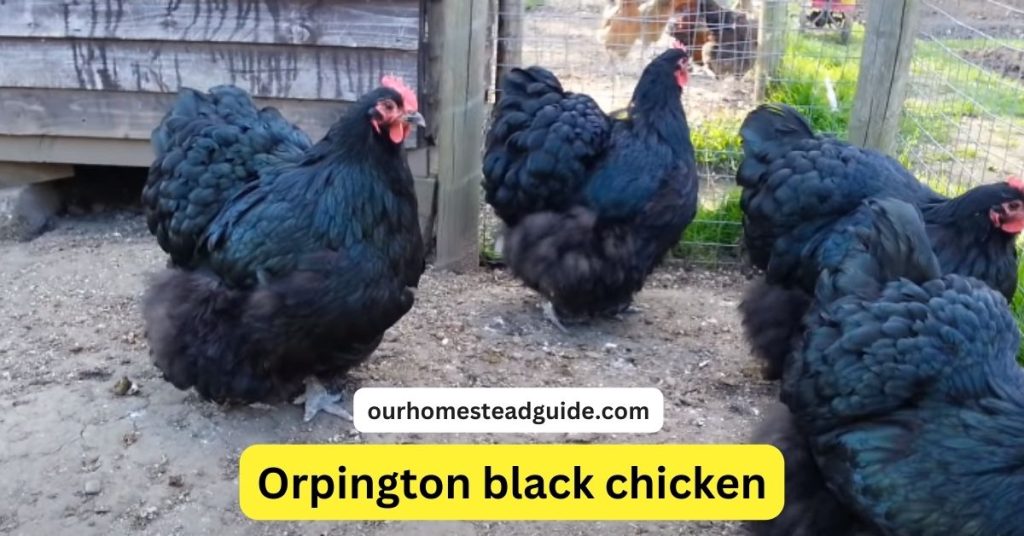
- Objective: Twofold
- Weight on average: 10 lbs.
- Production of Eggs: 150–300 yearly
One of the most popular breeds of chicken for backyard flocks is the Orpington. This type of bird, which is mostly black and has thick, fluffy feathers that enable it to quickly adapt to cold temperatures, originated in England in the eighteenth century.
Although they were originally white, Orpingtons are now also available in buff and black hues. They make excellent pets since they are calm, kind, and resilient. They are intriguing since they are among the hen kinds that are most devoted to their communities. In addition to finding food for their hens, the roosters will gather everyone at night to ensure that everyone has entered the coop.
This bird stands out in the barnyard thanks to its stunning black plumage, even if its skin is white and it does not have an all-black body. Although it may be produced for meat as well as eggs, eggs are the usual reason for raising it.
Every year, Orpingtons lay between 150 and 300 big brown eggs, many of which have a pink hue. Additionally, compared to other kinds of chickens, you may feed these less because they are superb foragers and will locate enough food on their own.
Australorp
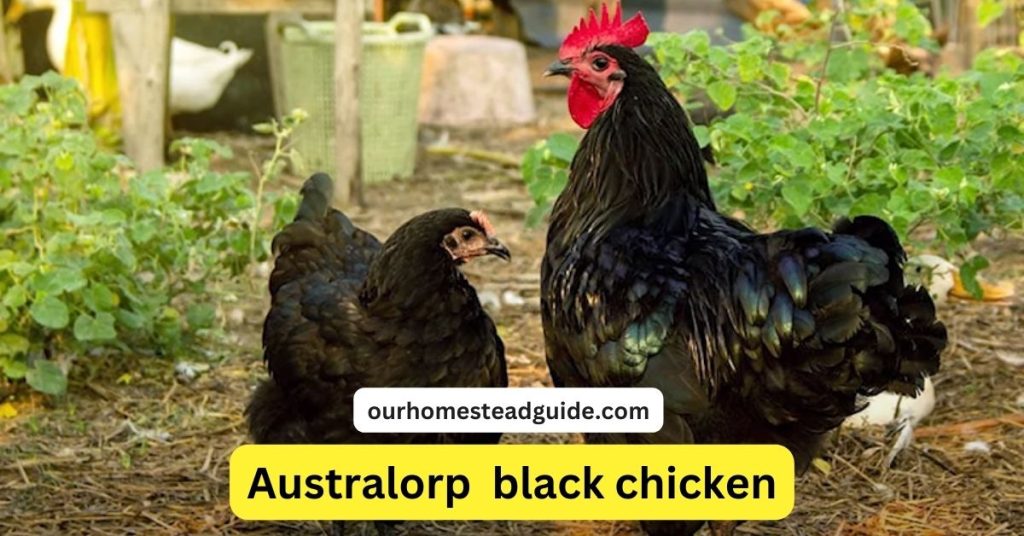
- Purpose: Dual-purpose
- Average Weight: 5-7 lbs
- Egg Production: 250 per year
Although Australians are available in a variety of hues, black is one of the most common. These stunning birds, which are an Australian hybrid of the Orpington breed, are rather easy to locate. Although they are quite kind and obedient, black Australorps may sometimes be very timid. There are Black Australians with green-tinged feathers as well.
The Black Australorp is a great choice if you want to keep black chickens as pets. These hens are not only quite beautiful to look at, but they also have a very devoted nature. A Black Australorp may be trained to eat right out of your hand.
Australorps are also excellent layers, laying a significant number of big brown eggs every week. The record for the most eggs laid in a year is held by an Australorp! They may also be reared to produce premium broilers for the meat market.
Silkies
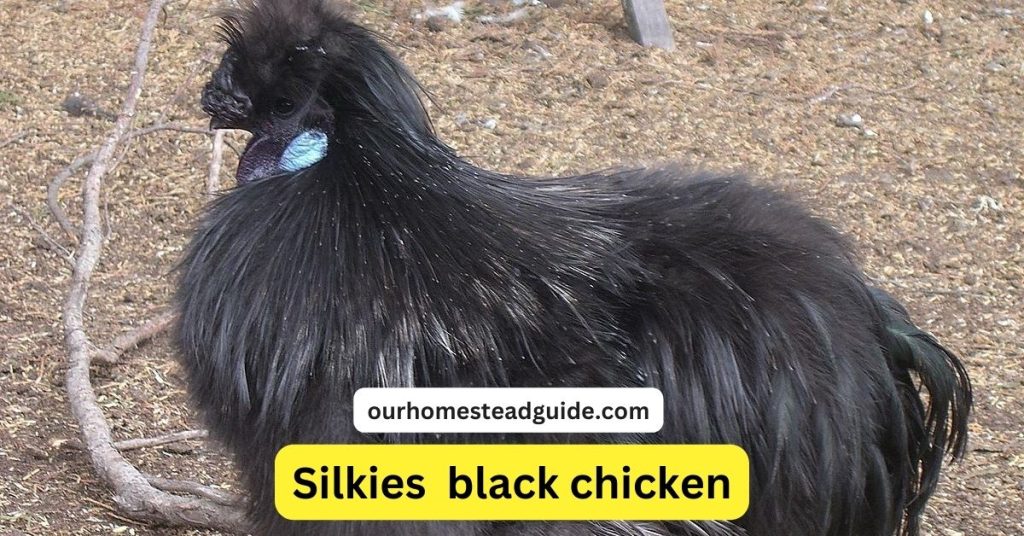
- Purpose: Ornamental
- Average Weight: 4 lbs
- Egg Production: 100 per year
Adorable silkies are among the most popular show and decorative hens. Although regular-sized Silkies can be bought in other countries, only the bantam form of this breed is sold in the United States.
The feathers of silkies are fluffy and black. Because of their unusual feather pattern, their feathers stand out rather than resting flat on their bodies. Although Silkies come in a variety of hues, black is one of the most widely used. Their skin and bones are similarly black.
Rather than having four toes, they have five, and even the color of their meat is a deeper gray-blue. Many areas consider Silkie meat to be a delicacy and think it to have curative properties.
Due to their petite size and fluffy coat, silkies are a popular choice for pets among poultry owners. A few proprietors even claim to have brought them inside the home! Even though silkies are just average layers, they make wonderful moms because of their serene, amiable personalities.
They have been developed specifically for this characteristic;, because Silkies have such a propensity to become broody, they are frequently used to “foster” eggs.
Remember that you must make sure your Silkie chicken has excellent living circumstances if you choose to raise one. These chickens are fully feathered, down to the feathers covering their feet, therefore getting their feet wet can easily create difficulties. They are great companions and rather talkative.
Minorca
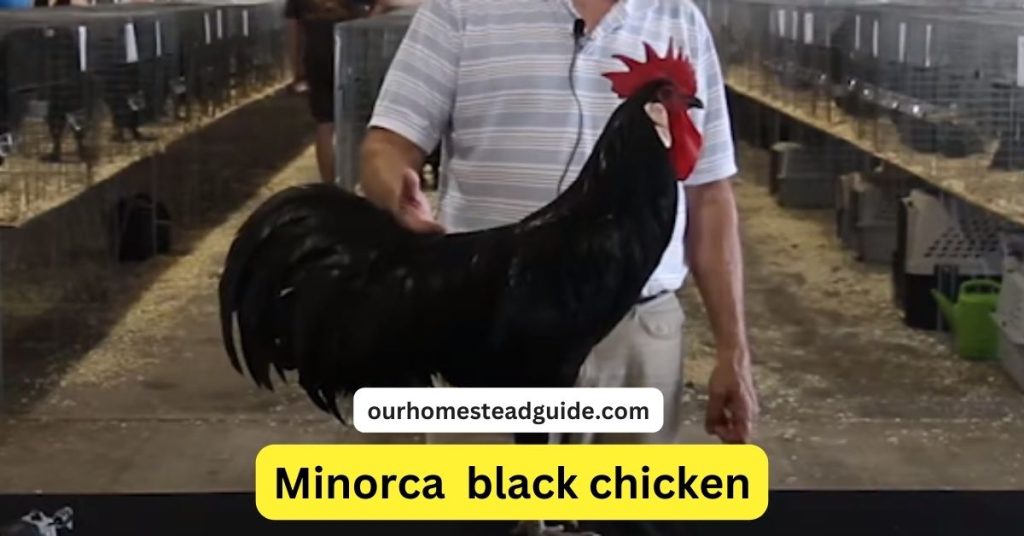
- Purpose: Ornamental/egg production
- Average Weight: 7-9 lbs
- Egg Production: 120-200 per year
Spanish-bred Minorca hens are usually grown as show or decorative breeds. These stunning birds sometimes referred to as Red-Faced Black Chicken, have light red cheeks. What’s interesting is that each hen makes a special presentation of her comb falling forward. Since they are warm-weather birds, you shouldn’t raise them if you live in a frigid climate.
Although there are numerous varieties of Minorca chickens, the Black Minorca is the most well-liked. The biggest of the Mediterranean type, this chicken has a red face and glossy black feathers. It is also quite amiable.
The roosters of minors may weigh up to seven pounds, making them huge birds. Sadly, they aren’t very good for eating despite their size, yielding flesh that isn’t flavorful or has the right texture. About 120 big white eggs should be laid each year, and as this bird seldom becomes broody, there won’t typically be drops in egg production at specific seasons of the year.
These hens begin to lay at about 26 weeks of age, and while 120 eggs is the breed average, certain strains can lay as many as 230 eggs annually. If you want a decorative bird that also happens to be a competent layer, these sleek, active chickens are a great option.
Sumatra
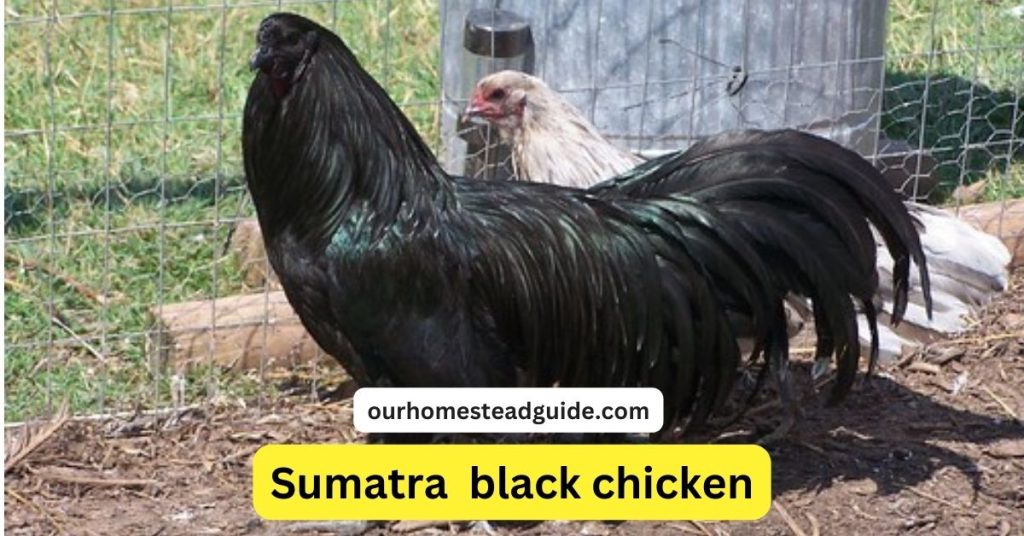
- Purpose: Ornamental
- Average Weight: 4 lbs
- Egg Production: 100 per year
Although they are indigenous to Sumatra in Indonesia, Sumatra chickens are also found in Borneo and Java. Although there are several colors available for these birds, black is the most commonly chosen. The entire body of the black chicken species of Sumatra chicken is covered in lustrous black feathers. This plumage culminates in a stunning waterfall-like display of tail feathers.
This bird has black feathers, but it also has black bones and skin. This chicken has a rich red hue on its face, wattles, and comb. These chickens, a fairly unusual breed, were originally raised as fighting cocks. They are known to be amiable birds, but in reality, they may be rather aggressive.
They are also not good birds to have around if you have little children since they will not get along with other birds in your flock or cattle. Sumatra chickens can fly rather well and have long, flowing tails. This feature, which makes them very resistant to predators, also necessitates having an incredibly tall fence to contain them.
On the other hand, Sumatra chickens are great display and attractive birds. They lay just one medium-white egg a week, making them mediocre layers. They also yield rough, gamey flesh, making them lousy meat birds. The biggest males barely reach a weight of three or four pounds, indicating that they are likewise rather little.
Langshan
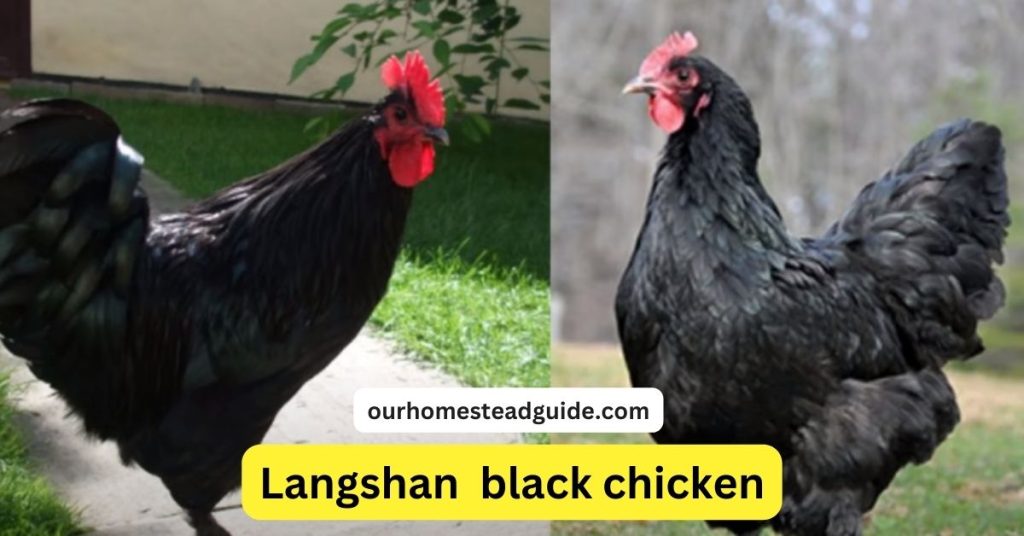
- Purpose: Dual-purpose
- Average Weight: 7-10 lbs
- Egg Production: 180 per year
It might be challenging to locate endangered Langshan chickens, especially Black Langshans. Their legs are covered with feathers, and the plumage ends just before the toes. They appear to be sporting leg warmers as a result! These beautiful and serene hens are a wonderful addition to any mixed flock.
The Langshan breed, which originated in China, takes its name from an area on the Yangtze Kiang River. Unfortunately, because most poultry distributors do not offer Langshan chickens, it is difficult to find these birds for sale. They are available in hatcheries that focus on historical or uncommon chicken breeds.
Because Langshan chickens are huge and generally docile, they may be added to almost any kind of flock. They are both independent and amiable, and they have clever, brilliant eyes.
Because Langsham birds have two uses, you may grow them for either meat or eggs. Every week, they provide an adequate quantity of meat with a fair flavor and an abundance of medium-sized brown eggs. These eggs are one of the deepest shades of brown that you will encounter.
Jersey Giant
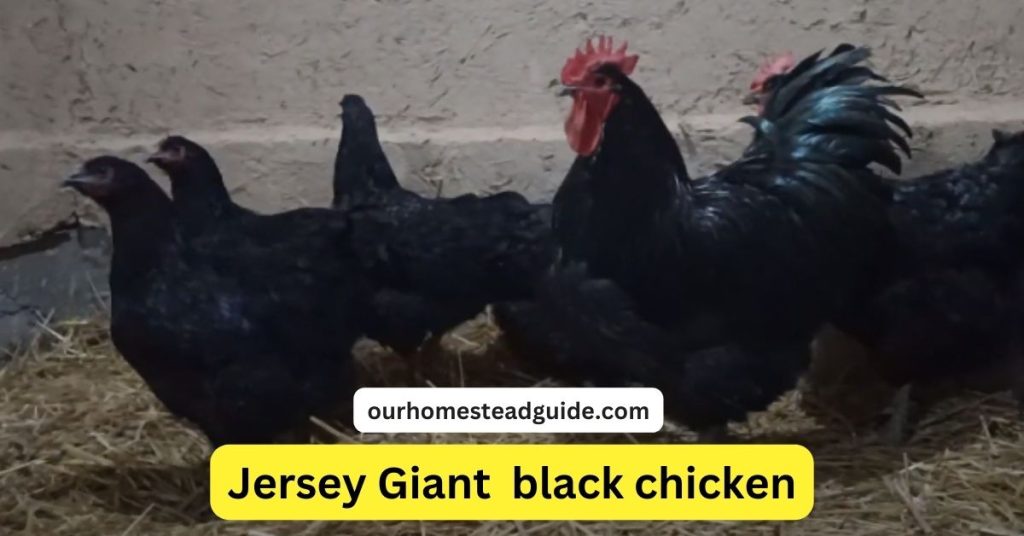
- Purpose: Meat production
- Average Weight: 11-15 lbs
- Egg Production: 150-200 per year
The Jersey Giant is the leader of the flocks in the barnyard, as his name suggests. However, they are also quite submissive. As a meat bird and substitute for turkeys, Jersey Giants were first domesticated in the United States. You won’t find a larger purebred chicken breed elsewhere.
Being among the larger varieties of chicken, these kinds and laid-back chickens will require a little bigger run and coop. Other than that, they are simple to care for, excellent companions, and excellent egg producers.
Every year, Jersey Giants lay about 150 very big brown eggs. They are also excellent as meat birds. These hens thrive in the cold, utilizing their plentiful body fat to keep warm, but they suffer in the heat. They do not, however, have any problems living in semi-confinement.
Even though these birds can weigh up to fifteen pounds, keep in mind that your hens will not be as heavy as the roosters. That being said, they are a fantastic choice for your backyard flock due to their balanced temperament and resistance to cold weather.
La Fleche
- Purpose: Dual purpose
- Average Weight: 6.5 lbs
- Egg Production: 200
You won’t regret choosing this uncommon breed of chicken for your poultry yard, despite its peculiar nature. La Fleche takes its name from the Paris, France-based competition in which it was first held. This breed, which dates back to the early 15th century, is known as the Devil’s Bird because of its peculiar look.
This chicken has two horn-like combs in addition to its all-black appearance. The bird is classified as highly endangered because it is a heritage breed. It is becoming more and more well-liked, mostly because it yields really tasty meat. Regretfully, this kind of chicken grows slowly; it will take it around 10 months to reach maturity. A hen weighs about 6.5 pounds.
These birds are dual-purpose, raised for both meat and eggs. Also kept as an ornamental bird, this chicken does well in confinement. However, it can be a bit wild and is difficult to tame. It does well in the heat but does not like living in cold environments.
Swedish Black
- Purpose: Egg production
- Average Weight: 5-7 lbs
- Egg Production: 150 per year
Swedish Black chickens are all-black birds that resemble Ayam Cemani in color, as one might expect. These chickens are all black, with skin, feathers, and bones that are all black because of a genetic abnormality shared with Ayam Cemani. Their tongues are black as well. But compared to Ayam Cemanis, Swedish Black chickens are significantly smaller and harder to locate.
Despite this, Swedish Black chickens have a more laid-back demeanor than Ayam Cemani and are great egg layers. In addition, they are far friendlier than their Indonesian counterparts, assuming the role of domestic chicken with greater grace. The serene Swedish Blackbird may lay over 150 cream-colored eggs annually.
Araucana
The Araucana chicken is named after the Araucania area of Chile and comes from South America. Relatively few kinds of chicken lay beautiful blue eggs, all descended from the Araucana. The Araucana chicken is rumpless and lacks a tail.
In addition, the breed’s noticeable ear tufts are connected to a deadly autosomal dominant trait. Two copies of this gene cause the death of the chicks either before or soon after hatching. In both bantam and big sizes, the APA acknowledges just five variants, but European authorities accept up to twenty colors.
Cochin Chicken
Originating in China, Cochin chickens are large, fluffy birds with heart-shaped feathers that reach their feet. Because of her love for this breed, Queen Victoria constructed a private aviary where she could spend time with a small flock that she received as a gift.
The hen craze that was created by cochin chickens caused the price of decorative hens to skyrocket as nobles flocked to emulate Queen Victoria’s influence. When the market burst, prices continued to skyrocket, and several breeds—like the Cochin chicken—suddenly lost popularity.
Cochin chickens are once again quite common as show birds nowadays. These resilient birds are recognized by the APA in nine colors for big sizes and 17 colors for bantam sizes.
Crèvecoeur Chicken
Possibly the earliest chicken to have come from France, the Crèvecoeur chicken got its name from the town of Crève-Coeur en Ange. There’s only one hue available for these shiny black fowl. The shaggy crests and beards of Crèvecoeur hens give them a rather unkempt appearance.
Their long, curved sickle feathers, which shimmer deeply and brightly in the sun, are used to maintain their tails upright. When Germany conquered France during World War II, the German soldiers almost completely devoured the Crèvecoeur chickens, almost resulting in their extinction.
Luckily, some farmers were able to conceal a few birds, ensuring the survival of the Crèvecoeur chicken. Breeders in France, Australia, and the US have been working to reestablish the breed since then, and it is slowly making a comeback.
Kadaknath Chicken
The Indian chicken known as Kadaknath probably came from the wild. The Kadaknath chicken carries a gene that results in fibromatosis, or melanin hyperpigmentation, just like the Indonesian Ayam Cemani. The bird’s epidermis and connective tissues become black as a result of these excessive deposits of dark pigment.
Jet black, penciled, and golden are the three recognized colors in India for the Kadaknath chicken, even though the APA does not now recognize it. The jet-black type is all-black on the inside and exterior due to its all-black feathers.
Because of excessive eating of its tasty black flesh, the Kadaknath chicken was on the verge of extinction. However, government authorities have tried to save the species by implementing a paid breeding program.
Leghorn Chicken
The majority of people associate Leghorn chickens with the industrial, white breed. But as of right now, the APA acknowledges black among the many hues of non-industrial Leghorn chickens. For the big variety, they mention six colors, while for the bantam species, they list eleven colors.
The Italian area of Tuscany is where the Leghorn chicken first appeared. Up to 320 white eggs can be produced annually by this strain. The industrial-type Leghorn is the cornerstone of the US commercial egg market. The majority of the white eggs you buy in supermarkets are produced there. Backyard flocks are more likely to have heritage-type Leghorn chickens.
Beautiful black chicken breeds
Here’s a tabular summary of some of the most well-liked black chicken breeds:
| Feature | Description |
|---|---|
| Breed Name | Ayam Cemani |
| Origin | Indonesia |
| Color | Black throughout (feathers, beak, skin, organs) |
| Egg Color | Cream to light brown |
| Egg Production | 15-20 eggs per month |
| Egg Price | Rs. 1,500 – Rs. 2,000 per egg |
| Chick Price | Rs. 3,500 – Rs. 4,000 per chick |
| Adult Hen Price | Rs. 40,000 – Rs. 45,000 |
| Meat Price | Not commonly eaten in Pakistan |
| Temperament | Calm and docile |
| Climate Tolerance | Adapts to various climates |
| Common Uses | Egg production, breeding, show birds |
| Special Feature | Unique black color due to a genetic mutation |
| Challenges | Higher initial investment, potential health issues |
Challenges of Raising Black Chicken Breeds
Although there are many benefits to producing black chicken breeds, there are also some difficulties to take into account:
Enhanced visibility: Compared to other colored chickens, black chickens are more noticeable to predators, which increases their vulnerability to attacks by foxes, hawks, and other animals. Additional safety measures are needed for this, such as a safe coop and run with appropriate fences and predator deterrents.
Heat absorption: In hotter temperatures, black feathers have a greater tendency to absorb heat than lighter feathers. Due to their potential susceptibility to heat stress, black chickens may need extra cooling techniques such as shade, air, and cool water to keep them comfortable.
Bleaching of feathers: In hotter regions, black feathers are more susceptible to fading or bleaching in the sun. This may have an impact on the chicken’s look and lower its market value for breeding or exhibition.
Restricted availability: Particularly in some areas, some black chicken breeds are uncommon and hard to locate. It could be difficult to find chicks or breeding stock as a result.
Costlier: Compared to other breeds, black chickens might be more costly, especially the uncommon or exotic types. This can be attributed to their restricted supply and rising demand.
Genetic challenges: Certain black chicken breeds are susceptible to illnesses like fibromatosis, which is breed-specific. Although not always dangerous, it might affect breeding decisions and call for additional caution.
Perception and market: Cultural or religious constraints may influence the market reach and possible profit of black chicken meat and eggs, particularly those sourced from certain breeds such as the Ayam Cemani.
Care requirements: Black chickens need the same routine maintenance as other kinds of chickens. However, depending on the breed and how susceptible they are to heat stress or other health issues, their exact demands may change.
Breeding difficulties: Some breeds have trouble keeping their pure black hue because other color genes might affect the progeny. Genetic expertise and meticulous breeding selection are needed for this.
Socialization: Compared to other breeds, certain black breeds may be more timid or reclusive. It can take more work to acclimate them to the flock and socialize them.
Advantages of Raising Black Chicken Breeds
Raising black chicken breeds offers several advantages over raising other colored breeds. Here are some of the key benefits:
Health benefits:
Rich source of carnosine: Compared to white chicken flesh, black chicken meat—especially that of breeds like the Kadaknath—has a greater carnosine content. Antioxidant carnosine reduces inflammation, guards against chronic illnesses, and strengthens immunity, among other health advantages.
Possible therapeutic benefits: Black chicken flesh is used to cure a variety of illnesses in some cultures where it is thought to have therapeutic benefits. Further study is necessary, however, some studies indicate that black chicken could have certain medical advantages.
More robust immune system: It’s thought that certain black chicken breeds have a more robust immune system than other varieties. Their innate capacity for foraging or their distinct genetic makeup might be the cause of this.
Aesthetic appeal:
Black chickens are distinguished from other chicken breeds by their gorgeous, glossy black plumage, giving them a distinctive and stunning look. They give your backyard flock a hint of refinement and elegance.
Black chickens have a stunning look that makes them a popular decorative fowl. They might be a stunning addition to any farm or garden.
Versatility: Black hens can be enormous Jersey Giants or tiny Silkies, depending on the size and breed. This enables you to select the ideal breed of black chicken for your requirements and tastes.
Other advantages:
tenacious and flexible: Due to their adaptability and hardiness, several black chicken breeds may thrive in a variety of conditions.
Good layers of eggs: Some black chicken breeds have great layers, so you can always count on receiving tasty, fresh eggs from them.
amiable and serene disposition: Certain black chicken varieties are well-known for having amiable and peaceful dispositions, which makes them perfect for households with young children.
Effective foragers: Black hens may supplement their diet with insects, worms, and other natural things since they are often adept foragers.
distinct niche market: Because black chicken goods are rare and thought to have health advantages, black chicken meat, and eggs can fetch a greater premium than white chicken products. This presents a potentially lucrative prospect for small-scale growers.
Why Do Certain Chicken Species Have All-Black Colors?
The pigmentation of feathers, skin, and other tissues is largely controlled by hereditary factors, which account for the black appearance of some chicken breeds. The pigment known as melanin is the primary cause of black color in chickens.
There are two primary types of melanin: pheomelanin, which produces red and yellow hues, and eumelanin, which gives black and brown hues. The genetic composition of the chicken determines the distribution and strength of these hues.
Ayam Cemani, Black Australorp, Black Jersey Giant, and Black Copper Marans are among the breeds whose plumage is primarily black due to selective breeding that has been done to promote eumelanin expression.
Particularly the Ayam Cemani is recognized for having a rare genetic condition known as fibromelanosis, which results in hyperpigmentation and gives the bird a fully black appearance on the outside as well as the inside.
Breeders have been able to maintain and improve the expression of specific color features via years of selective breeding. These breeds’ black coloration is a result of the interplay between certain genes and their existence. Note that although all of these hens may seem black, individual birds may differ somewhat in terms of color, gloss, or iridescence.
Beyond aesthetics, the dark tint can offer some useful benefits, such as improved concealment in some settings. To protect the well-being of the hens, color-brained hens should constantly take into account their general health, temperament, and functioning.
Beyond aesthetics, the dark tint can offer some useful benefits, such as improved concealment in some settings. To maintain the welfare of the flock, color-biased breeding should, however, always take the hens’ general health, temperament, and functioning into account.
Where Can I Buy a Black Chicken Breed?
Where to Find Black Chickens:
- nearby hatcheries: Verify whether any black breeds are available.
- Online hatcheries: Investigate rarer kinds and a larger assortment.
- Breeders specializing in: Get in touch with black breed breeders.
- Backyard cultivators: Make a local connection for eggs or chicks.
- Shows featuring poultry: Meet breeders and view breeds in person.
- Auctions for poultry: Take care while placing a bid on black chickens.
- Internet-based markets: Seek listings with platform safeguards and verified merchants.
Remember:
Look up local laws: Certain places forbid black breeds.
Select a breed that will work for you: Think about temperament, climate, and purpose.
Put your health and well-being first: Pick a reliable vendor who has well-groomed, socialized birds.
Most Frequently Asked Questions!
1. What is the Ayam Cemani?
An uncommon and unusual breed of chicken that originated in Indonesia is called Ayam Cemani. Its complete appearance—featuring black skin, feathers, wattles, comb, and even internal organs—is well-known.
2. Why are Ayam Cemani Chickens Black?
Ayam Cemani chickens’ black coloring is caused by a hereditary disorder known as fibromatosis. This disease leads to hyperpigmentation, which is the overproduction of pigments in the tissues of the chicken.
3. Are Ayam Cemani Chickens Expensive?
Indeed, when compared to other chicken breeds, Ayam Cemani birds are often more costly. The breed’s scarcity and distinctive all-black traits drive up the price of these animals.
4. Can Ayam Cemani Chickens Lay Black Eggs?
No, the eggs laid by Ayam Cemani hens are usually colored or cream in color. There is no black coloring in their eggs.
5. Do Ayam Cemani Chickens Have Black Meat?
Ayam Cemani birds have partially black flesh, while their skin, bones, and internal organs are all black. Although not quite black, it is dark. The dark coloring is partly attributed to the feathers and connective tissues.
6. Are There Other Black Chicken Breeds?
Indeed, there are more black chicken breeds than Ayam Cemani, such as the Sumatra and Swedish Black Hens. The most well-known feature of Ayam Cemani, nevertheless, is its full black coloration.
7. Are Ayam Cemani Chickens Good Layers?
The Ayam Cemani chicken breed is not renowned for its high egg-laying ability. Rather of being preserved for their large egg production, they are kept more for their unique and decorative traits.
8. How Can I Care for Ayam Cemani Chickens?
A balanced feed, appropriate housing, and routine health examinations are all part of caring for Ayam Cemani hens. It’s also essential to make sure their surroundings are safe from predators.
9. Where Can I Buy Ayam Cemani Chickens?
Owing to their scarcity, Ayam Cemani hens might be hard to locate. Ayam Cemani, however, could be sold by breeders and specialist poultry farms. It’s crucial to do your homework and make sure the vendor you choose is reliable.
10. Are Ayam Cemani Chickens Suitable for Beginners?
Ayam Cemani hens are rare, expensive, and require special care, so they might not be the ideal option for novices. It could be more sensible for those who are new to raising chickens, to begin with more popular and manageable breeds.
you may also like this article.

